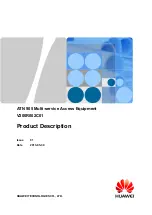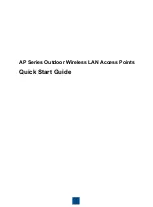
161
Copyright © 2004-2005, Vivato, Inc.
educational institutions,
.net
for network operators, and
.org
for other organizations as well as
.gov
for
the U. S. government and
.mil
for its armed services.
DOM
The
Document Object Model
(DOM) is an interface that allows programs and scripts to dynamically access
and update the content, structure, and style of documents. The DOM allows you to model the objects in an
HTML or XML document (text, links, images, tables), defining the attributes of each object and how they
can be manipulated.
Further details about the DOM can be found at the
DTIM
The
Delivery Traffic Information Map
(DTIM) message is an element included in some
frames. It
indicates which stations, currently sleeping in low-power mode, have data buffered on the
awaiting pick-up. Part of the DTIM message indicates how frequently stations must check for buffered
data.
Dynamic IP Address
See
.
EAP
The
Extensible Authentication Protocol
(EAP) is an authentication protocol that supports multiple methods,
such as token cards, Kerberos, one-time passwords, certificates, public key authentication, and smart
cards.
Variations on EAP include EAP Cisco Wireless (LEAP), Protected EAP (PEAP), EAP-TLS, and EAP
Tunnelled TLS (EAP-TTLS).
ESS
An
extended service set
(ESS) is an
with multiple
AP/Bridges, forming a single subnetwork that can support more clients than a basic service set (
).
Each AP/Bridge supports a number of wireless stations, providing broader wireless coverage for a large
space, for example, an office.
Ethernet
Ethernet
is a local-area network (
) architecture supporting data transfer rates of 10 Mbps to 1 Gbps.
The Ethernet specification is the basis for the
standard, which specifies the physical and lower
software layers. It uses the
access method to handle simultaneous demands.
Ethernet supports data rates of 10 Mbps,
Fast Ethernet
supports 100 Mbps, and
Gigabit Ethernet
supports
1 Gbps. Its cables are classified as "
X
base
Y
", where
X
is the data rate in Mbps and
Y
is the category of
cabling. The original cable was
10base5
(Thicknet or "Yellow Cable"). Some others are
10base2
(Cheapernet),
10baseT
(Twisted Pair), and
100baseT
(Fast Ethernet). The latter two are commonly
supplied using
CAT5
cabling with
RJ-45
connectors. There is also
1000baseT
(Gigabit Ethernet).
ERP
The
Extended Rate Protocol
refers to the protocol used by
stations (over 20 Mbps
transmission rates at 2.4GHz) when paired with Orthogonal Frequency Division Multiplexing (OFDM). Built
















































